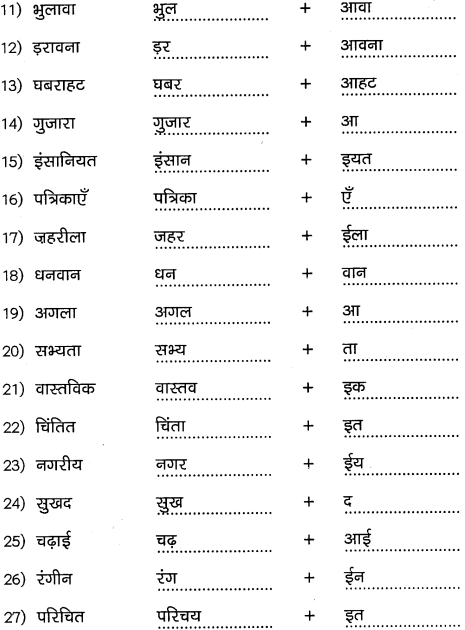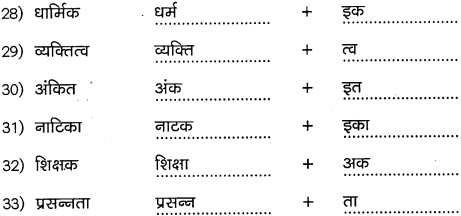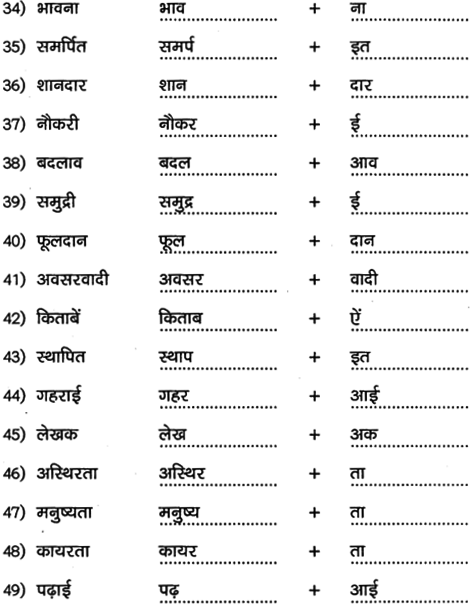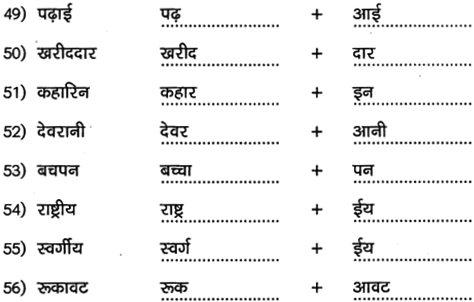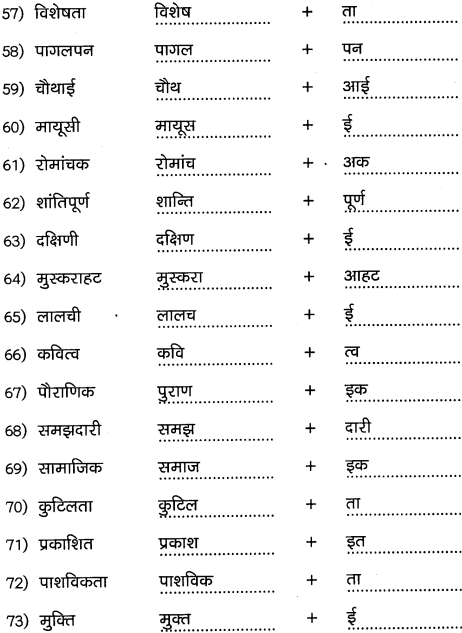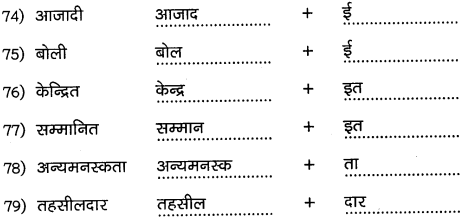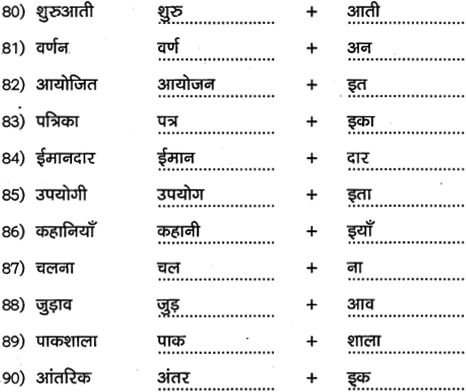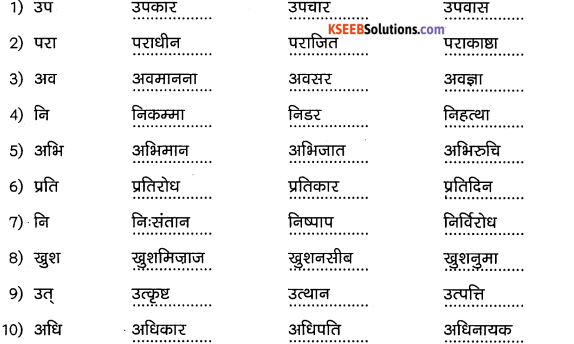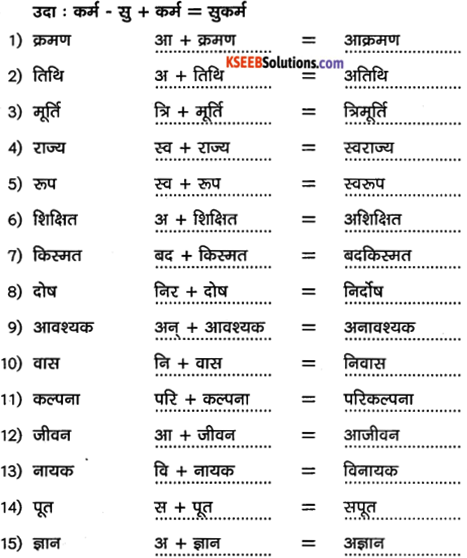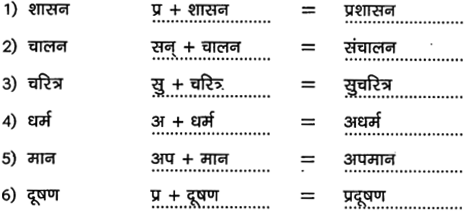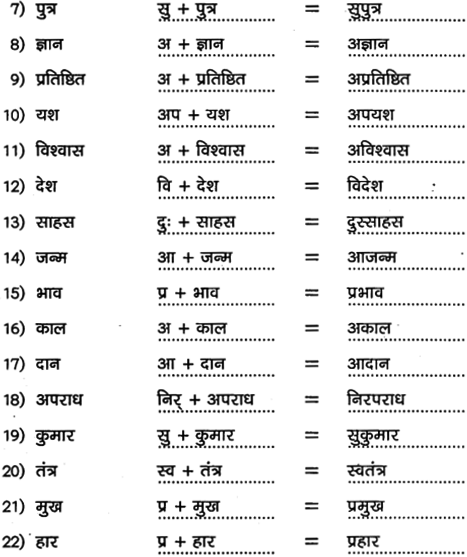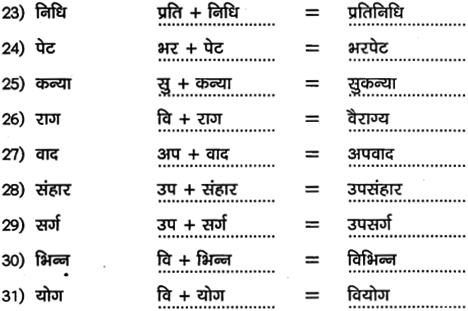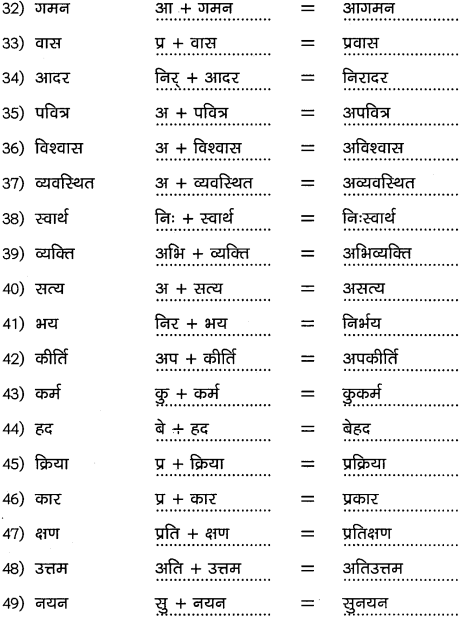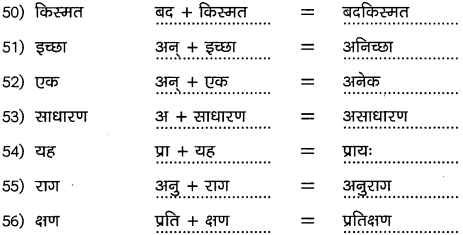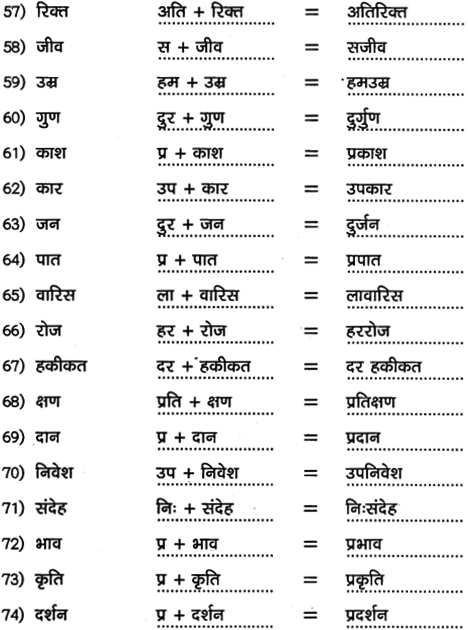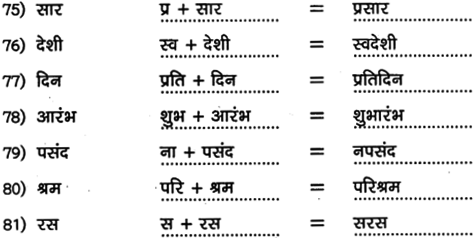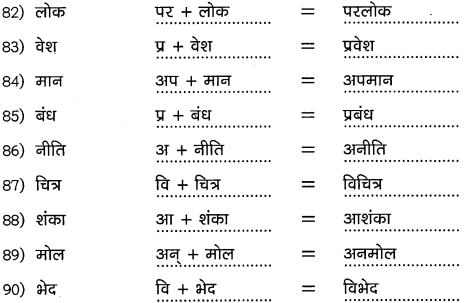Karnataka 1st PUC Sociology Question Bank Chapter 3 Social Process
You can Download Chapter 3 Social Process Questions and Answers, Notes, 1st PUC Sociology Question Bank with Answers Karnataka State Board Solutions help you to revise complete Syllabus and score more marks in your examinations.
1st PUC Sociology Social Process One Mark Questions and Answers
Question 1.
What is Social interaction?
Answer:
Social interaction is the foundation of society. It is very essence of social life.
Question 2.
What is social contact?
Answer:
Social contact means simply a coming together of independent units. It involves a mutual response, an inner adjustment of behavior to the actions of others.
Question 3.
What is Communication?
Answer:
Communication is the medium of interaction
Question 4.
Mention any one element of interaction.
Answer:
Contact and communication.
Question 5.
What is co-operation?
Answer:
Co-operation is one of the basic pervasive and continuous social process. It generally means “working together for the pursuit of the common goal”.
![]()
Question 6.
Mention any one feature of Co-operation.
Answer:
- Co-operation is universal and continuous
- Perception of common goals.
Question 7.
Mention any one form of Co-operation.
Answer:
Direct co-operation and Indirect Co-operation.
Question 8.
What is direct Co-operation?
Answer:
In the direct co-operation action the individuals involved to do the identical function. ,
Question 9.
What is indirect Co-operation?
Answer:
In this case people work individual for the attainment of a common end.
Question 10.
What is Competition?
Answer:
Competition is the most fundamental form of social struggle.
Question 11.
Mention any one form of competition.
Answer:
Social competition, economic competition etc.
Question 12.
Mention any one feature of Competition.
Answer:
- Scarcity as a condition of competition
- Competition and affluence.
![]()
Question 13.
State any one importance of Competition.
Answer:
Social Competition.
Question 14.
What is conflict?
Answer:
Conflict is an ever- present process in human relations.
Question 15.
State any one feature of conflict.
Answer:
- Conflict is universal
- Conflict is a conscious action.
Question 16.
Mention any one form of conflict.
Answer:
War, feud and factional strife, litigation, conflict of impersonal ideas.
Question 17.
” What is Feud?
Answer:
Feud is an extra group conflict. It may arise because of injustice alleged to have been done by one group to another.
Question 18.
What is litigation?
Answer:
Litigation is ajudicial form of conflict.
Question 19.
What is accommodation?
Answer:
Accommodation is one of the principal types of social processes.
Question 20.
Mention any one feature of accommodation.
Answer:
- Accommodation is the natural result of Conflict
- Accommodation is Universal.
Question 21.
Mention any one method of accommodation.
Answer:
- Yielding to coercion
- Compromise.
Question 22.
What is coercion?
Answer:
Coercion involves the use of force or the threat of force for making the weaker party to accept the conditions of agreement.
Question 23.
What is compromise?
Answer:
Compromise each party to the dispute makes some concessions and yield to some demand of the other.
![]()
Question 24.
What is sublimation?
Answer:
Adjustment by means of sublimation involves the substitution of non-aggressive attitudes and activities for aggressive ones.
Question 25.
What is assimilation?
Answer:
Assimilation is one of the types of interaction.
Question 26.
Mention any one characteristic of assimilation.
Answer:
Assimilation is not confined to single field only.
Question 27.
Mention any one factors that is favorable of assimilation.
Answer:
Intimate social relationships.
1st PUC Sociology Social Process Two Marks Questions and Answers
Question 1.
Mention any two types of communication.
Answer:
The two types of communication are:
- Emotions,
- Sentiments.
Question 2.
What is social processes?
Answer:
Social interaction is the foundation of society. It is the very essential of social life.
Question 3.
Mention any two types of social process.
Answer:
Co-operation, competition, conflict, accommodation and assimilation.
![]()
Question 4.
How is the term ‘Co-operative’ derived.
Answer:
The term co-operation is derived from the Latin word ‘co’ meaning ‘together’ and ‘operari’ meaning to work.
Question 5.
Mention two types of Co-operation.
Answer:
Direct co-operation and indirect co-operation.
Question 6.
Mention two advantages of Co-operation.
Answer:
- Co-operation helps society to achieve progress
- Co-operation provides solutions for many international problems and disputes.
Question 7.
What is competition.
Answer:
According to Biesanz and Biesanz: “ Competition is the string of two or more persons for the same goal which is limited so that all cannot share”.
![]()
Question 8.
Mention any two types of competition.
Answer:
- Social competition
- Economic competition
- Political competition
- Cultural competition.
Question 9.
Mention any two functions of competition.
Answer:
- Source of motivation
- Assigns statuses to the individuals
- Provides for new experience
- Provides for social mobility.
Question 10.
What is conflict?
Answer:
According to A.W. Green “ Conflict is the deliberate attempt to oppose, resist or coerce the will of another or others”.
Question 11.
Mention Simmel’s foul types of conflict.
Answer:
- War
- Feud and factional strife
- Litigation
- Conflict of impersonal ideas.
Question 12.
What is accommodation?
Answer:
According to Ogburn and Nimkoff: “Accommodation is a term used by the sociologists to describe the adjustment of hostile individuals or groups”
Question 13.
Mention any two types of accommodation.
Answer:
- Yielding to coercion
- Compromise
- The role of third party in compromise
- Toleration.
![]()
Question 14.
What is rationalization?
Answer:
This involves excuses or explanations for ones’ behavior. One is not prepared to acknowledge one’s failures or defects for it may indicate guilt or the need for change.
Question 15.
What is assimilation?
Answer:
According to Young and Mack: “Assimilation is the fusion or blending of two previously distinct groups into one”.
Question 16.
Mention any two features of assimilation.
Answer:
- Assimilation is not confined to single field only
- Assimilation is a slow and gradual process
Question 17.
Mention any two factors that is favorable of assimilation.
Answer:
- Toleration
- Intimate social relationships
- Amalgamation or intermarriage.
- Culture similarity.
1st PUC Sociology Social Process Five Marks Questions and Answers
Question 1.
What is Social interaction? Explain the conditions of social interaction?
Answer:
Social interaction is the foundation of society. It is the very essence of social life. Hence, the concept is crucial to any study of the dynamics of society and culture without interaction there would be no group life. Thus, it can be said that interaction is the basic social process, the broadest term for describing dynamic social relationships. Social interaction represents the dynamic nature of human society. It is true the life is stable, confined and defined by traditional systems, norms and patterned ways.
Life is dynamic. People are on the move they are striving, competing, conflicting, Co-operation, appeasing, adjusting, reconciling and then challenging again. This action element or functional element itself represents social interaction Direct and Symbolic interaction Interaction may be direct or symbolic. Direct interaction refers to the activities of person which may be seen in such conduct as pushing fighting, pulling, embracing dishing or in other forms of bodily contact with other gestures and language, spoken or written.
A symbol is a summary of experience. It may represent an object, act, quality, value idea or any expected response. Language is the rich storehouse of such symbols. The centre nature of interaction is inter stimulated and response. One stimulates the actions, thoughts or emotions of another persons and response to the similar behavior of the others. Interaction increases mental activity, fosters comparison of ideas, sets new tasks, accelerates and discovers the potentialities of the individual.
According to N. P. Gish “Social interaction is the reciprocal influence human begins exert on each other through inter stimulation and response”. According to Dawson and Gettys: “Social interaction is a process where by men interpenetrate the minds of each other”.
![]()
Question 2.
What is social processes? Explain.
Answer:
According to Maclver and Page: “Social processes is the manner in which the relationship of the members of a group, once brought together, acquire a distinctive character”.
According to A. W. Green: The social processes are merely the characteristics ways in which interaction occurs”.
The society’ is a system of social relationship. We may witness such relationship between father and son, employer and employee, teacher and student, merchant and customer, leader and follower or between friends and enemies, between children etc., socialogy must analyze and classify social relationship because they represent social fact and social data.
Social relationship represents the functional aspects of society. Analyzing and classifying social relationship is a difficult task. Social relationship involve reciprocal obligations. It refers to a pattern of interaction between these individuals thus social relationships may be studied by the kind or mode of interaction. It exhibit kinds of interaction are called social processes. Social processes are the fundamental ways in which men interact and establish relationships.
Types of Social processes:
There are five types of social process.
Social interaction assumes different forms, Cooperation, competition, conflict, accommodation and assimilation are very necessary social interactions.
![]()
Question 3.
Describe the two fold classified of Co-operation.
Answer:
Types of Co-operation:
The types of co-operation can be discussed in the following ways:
1. Direct Co-operation: In the direct cooperation action the individual involved to do the identical function. Ex. Playing together worshiping together, tilling the field together, taking out a cut from the mud, etc., people do work in company with other members, performance of a common task with joint efforts brings them social satisfaction.
2. Indirect Co-operation: In this case people work individually for the attainment of a common end. People do tasks towards a similar end. This is based on the principle of division of labor and specialization. For ex. Farmers, spinners, weavers, dyers, tailors are different and engaged in different activities. But their end remains the same, that of producing clothes. The modem technological age requires specialization of skill and functions, hence it depends on Co-operation.
Sociologi st have also spoken of three other types of Co-operation, namely Primary Co¬operation Secondary Co-operation and tertiary Co-operation. These types are witnessed in primary groups, secondary groups and between two or more groups respectively.
Question 4.
Co-operation has becomes an inseparable aspects of our modern social life? Explain
Answer:
The importance of Co-operation are:
1. Co-operation is universal and continuous: It is a form of social process is not only universal but also continuous. Co-operation makes possible same understanding and adjustment between individuals and groups without which social life is impossible. Co-operation is hailed as the very basis of the communication life of men.
2. Perception of common goals: Individual indulging in Co-operative interaction are aware of some goals. The goal may be winning a victory in a battle, winning a hockey match, students making a combined study and so on perception of a common goal often draws people together.
3. Collective work for common rewards: Co-operation involves combined or collective efforts, rewards are normally shared by them, for example the reward may be match victory or profit shared in an Industry.
4. Co-operation is not necessarily unselfish: It is generally believed to be unselfish, but men may also find that their selfish goals are best served by working together with their fellows. Groups may Co-Operate for self-advancement as in the case of a monopoly or mutual protection, or for the welfare of all groups of people.
5. Essential conditions of Co-operation: According to Young and Marck Co-operation takes under some conditions. They are as follows. Firstly, Co-operation requires a motivation to seek a goal. Secondly, people must have some knowledge of the benefits of Co-operative activity. This requires some kind of education and must have a favorable attitude towards sharing both the work and the rewards involved.
6. Psychological qualities necessary for the developing Co-operative attitudes: Co-operation requires sympathy and identification, Sympathy depends upon the capacity of the individual to imagine himself in the place of another, particular when the other person is in difficulties. Mutual aid is another name for Co-operation. Co-operation is possible only when there is like mindedness. Similarity of purpose, mutual awareness, mutual understanding, mutual helpfulness and selfless attitudes.
![]()
Question 5.
What is competition? Explain its major types.
Answer:
Competition plays an important role in social life. Competition performs a number of useful functions in society.
The major types are:
(a) Social Competition: People always compete to get into higher status and position, Competition of this kind is mostly observed in ‘open’ societies. Wherever individual ability, merit, talents and capacities are recognized.
(b) Economic Competition: The most important and at the same time the most vigorous forms of Competition is the economic Competition. It is witnessed in the processes of production, distribution and consumption of goods
(c) Political Competition: In the modern world Competition for political power is always present. Political parties are always engage in Competition to secure power. Such a Competition becomes apparent especially during elections.
(d) Cultural competition: Some sociologists have also spoken of cultural competition. It may take place between two or more cultural groups. Human history provides various example of such a Competition.
(e) Racial competition: Competition may also take place between racial groups such as the Blacks and the Whites, Aryans and Dravidians etc.
Question 6.
Describe the characteristics of Co-operation.
Answer:
The nature of Co-operations are:
1. Co-operation is universal and continuous: It is a form of social process is not only universal but also continuous. Co-operation makes possible same understanding and adjustment between individuals and groups without which social life is impossible, Co-operation is hailed as the very basis of the communication life of men.
2. Perception of common goals: Individual indulging in Co-operative interaction are aware of some goals. The goal may be winning a victory in a battle, winning a hockey match, students making a combined study and soon perception of a common goal often draws people together.
3. Collective work for common rewards: Co-operation involves combined or collective efforts, rewards are normally shared by them, for example the reward may match the victory or profit shared in an Industry.
4. Co-operation is not necessarily unselfish: It is generally believed to be unselfish, but men may also find that their selfish goals are best served by working together with their fellows. Groups may Co-Operate for self-advancement as in the case of a monopoly or mutual protection, or for the welfare of all groups.
5. Essential conditions of Co-operation: According to Young and Marck Co-operation takes under some conditions. They are as follows. Firstly, Co-operation requires a motivation to seek a goal. Secondly, people must have some knowledge of the benefits of Co-operative activity. This requires some kind of education and must have a favorable attitude towards sharing both the work and the rewards involved.
6. Psychological qualities necessary for the developing Co-operative attitudes: Co-operation requires sympathy and identification, Sympathy depends upon the capacity of the individual to imagine himself in the place of another, particular when the other person is in difficulties. Mutual aid is another name for Co-operation. Co-operation is possible only when there is like mindedness. Similarity of purpose, mutual awareness, mutual understanding, mutual helpfulness and selfless attitudes.
Types of Co-operation:
The types of co-operation can be discussed in the following ways:
1. Direct Co-operation: In the direct cooperation action the individual involved to do the identical function. Ex. Playing together worshiping together, tilling the field together, taking out a cut from the mud, etc., people do work in company with other members, performance of a common task with joint efforts brings them social satisfaction.
2. Indirect Co-operation: In this case people work individually for the attainment of a common end. People do tasks towards a similar end. This is based on the principle of division of labor and specialization. For ex. Farmers, spinners, weavers, dyers, tailors are different and engaged in different activities. But their end remains the Same, that of producing clothes. The modem technological age requires specialization of skill and functions, hence it depends on Co-operation.
Sociologist have also spoken of three other types of Co-operation, namely primary Co-operation Secondary Co-operation and tertiary Co-operation. These types are witnessed in primary groups, secondary groups and between two or more groups respectively.
![]()
Question 7.
Explain functions of competition.
Answer:
Importance or function of competition:
Competition plays an important role in social life. Competition performs a number of useful functions in society. Some of them may be noted here
1. Source of motivation: Competition is a source of motivation for the individuals. It makes the individual to show his ability and express the talent. It increases individual efficiency. Assigns statuses to the individuals: Competition assigns individuals their respective place in the social system. Social status and competition are always associated Some people complete with others to retains their status, other complete to enhance their status.
2. Provides for new experiences: As Ogburn and Nimkoff has pointed the individuals better opportunities to satisfy their desires for new experiences and recognition. As far as the group is concerned Competition means experimental charge.
3. Competition contributes to Socio-economic progress: Fair Competition is conducive to economic as well as social progress. It even contributes to general welfare because it spurns individuals and groups on to exert their best efforts. When the Competition is directed to promote the general interests of community as a whole, it can bring about miraculous results.
4. Provides for social mobility: As far as the individual is concerned. Competition implies mobility and freedom. The spirit of Competition helps the individual to improve his social status.
Question 8.
Competition has become an separable aspect of our life? Explain.
Answer:
Competition has become an separable aspect of our life in following ways:
1. Scarcity as a condition of competition: Wherever there are community desired goods and services, there is Competition. In fact, economics starts with its fundamental proposition that while human wants are unlimited the resources that can satisfy these wants are strictly limited. Hence people complete for the possession of these limited resources. As Hamilton pointed out Competition is necessitated by “a population of insatiable wants and a world of stubborn and inadequate resources”.
2. Competition and affluence: Competition may be found even in circumstances of abundance or affluence. In a time of full employment, Competition may take place for the status of the top class. There is Competition not only for food, shelter and other basic needs but also for luxuries, power, name, fame, social position, mates and so on.
3. Competition is Universal: Modem civilized society is marked by the Phenomenon of Competition. Competition is covering almost all the areas of customers, lawyers for clients, doctors for patients, students for ranks or distinctions, athletes and sportsmen for trophies, political parties for power, no society can be said to be exclusively Competition or co-operative.
4. Competition is continuous: Competition is continuous. It is found virtually in every area of social activity and social interaction. Particularly Competition for status, wealth and fame is always present in almost all societies.
5. Competition is dynamic: It stimulates the achievement and contributes to social change to higher level. A college student who completes with others to get selected to the college cricket team. After becoming successful may later struggle to get selected to the University cricket team, to the state team to the national team and so on.
6. Competition is always governed by norms: Competition is not limitless nor is it unregulated. There is no such things as ‘unrestricted competition’ such a phrase I contradiction in terms. Moral norms or legal rules always govern and control competition competitors are expected to use ‘fair tactics’ and not ‘cut-throat devices’.
7. Competition may be unconscious also: Competition may take place on an unconscious level. Many times individuals engaged in Competition are not always aware of the fact that they are in a Competitive race.
8. Competition may be constructive or destructive: Competition may be healthy or unhealthy. If one of the two or more competitor tries to win only at the expense of the others, it is destructive. Sometimes, big industrialists or businessmen to become virtually bankrupt. But constructive competition is mutually stimulating and helpful. It contributes to the welfare of all at large.
9. Competition may be personal or impersonal: Competition is normally directed towards a goal and not against any individual. Sometimes, it takes place without a actual knowledge of other’s existence. Ex. It is impersonal as in the case of civil service examination in which the contestants are not even aware of one another’s identity. Competition may
also be personal as when two individuals contest for election to an office. As competition becomes more personal., it leads to rivalry and shades into conflict. Competition in the social world is largely impersonal. The individual may be vaguely aware of, but has no personal contact with other competitors.
![]()
Question 9.
Explian Simmel’s typology of conflict.
Answer:
George Simmel has distinguished four types of conflict
(a) war
(b) feud or rational strife
(c) litigation
(d) conflict of impersonal ideas.
(a) War: According to Simmel war represents a deep seated antagonistic impulse in men. But to bring out this impulse into action some define objectives is needed. The objective may be the desire to gain material interests.
(b) Feud and factional strife: This is an intra-group conflict. It may arise because of injustice alleged to have been done by one group to another.
(c) Litigation: Litigation is a judicial form of conflict. It is a judicial struggle by an individual or group to protect right to possessions. This kind of conflict is more objectives in nature.
(d) Conflict of impersonal ideas: This is a conflict carried on by the individuals not for themselves but for an ideal. In such a conflict each party attempts to justify truthfulness of its own ideas. For ex, the communists and Capitalists carry on conflicts to prove that their own system can bring in a better world order.
Question 10.
Explain the characteristics of accommodation.
Answer:
According to Ogburn and Nimkoff: “Accommodation is a term used by the sociologists to describe the adj ustment of hostile individuals or groups”. Maclver says that “the term Accommodation refers particularly to the process in which man attains a sense of harmony with his environment.
Characteristics of Accommodation:
1. Accommodation is the natural result of Conflict: Since conflicts cannot take place continuously they involved in conflict do not relish the sense of conflict they sit down for it settlement. Such settlements temporary or permanent may be called “Accommodation” in the absence of conflict the question of arriving at accommodation does not arise.
2. Accommodation may be a conscious or an unconscious: Man’s adjustment with the social environment is mostly unconscious. From birth to death man to be behave in conformity with the normative order. The new bom individual learns to accommodate himself with the social order which is dedicated by various norms such as customs, morals, traditions etc. Thus, unconsciously the new bom individual accommodation himself with his family, caste or race, neighborhood. Life is full of such unconscious accommodative activities.
3. Accommodation is Universal: Accommodation as a ‘condition’ and as a ‘process’ is universal. Human society is composed to antagonistic elements and hence conflicts are inevitable. Since no society becomes necessary. Thus accommodation is found in all societies and in all fields of social fife.
4. Accommodation is continuous: The process of accommodation is not confined to any particular stage in the life of an individual It is not limited to any fixed social situation also. On the contrary, throughout the life one has to accommodate oneself with various situations, further, as and when conflicts take place sooner or later accommodation would follow not only the individuals but also the groups within the society are obliged to accommodate among themselves.
5. The effects of accommodation may vary with the circumstances: It may act to reduce the conflict between persons or groups as an initial step towards assimilation. It may serve to postpone outright conflict for a specific period of time, as in a treaty between nations or labor.
Management agreement. It may permit groups marked by sharp social-psychological distance to get along together. It may prove to be beneficial for the parties involved in it. Sometimes it may help the superior or more powerful party to party to impose it on the weaker party.
Question 11.
Describe the role of the third party of compromise.
Answer:
The role of third party in compromise:
1. Arbitration: When the contending parties themselves are not able to resolve their differences they may resort to arbitration. Arbitration is a device for bringing about compromise in which a third party tries to bring about an end to the conflict. Here the decision of the third party is binding on both the parties. Labour management disputes, some political disputes are often resolved in this way.
2. Mediation: Mediation is more a kin to arbitration. This involves the introduction into the conflict of a neutral agent whose efforts are directed towards bringing about a peaceful settlements. But the mediator has no power to settle the conflict as but the mediator has no power to settle the conflict as such for his decisions are not binding on the parties.
3. Conciliation: Closely related to compromise is conciliation. This is an attempt to persuade the disputants to develop friendship and come to an agreement. Conciliation has been used in industrial, racial and religious struggles. Conciliation implies a milder response to an opponent than coercion. In the end conciliation, like toleration opens the door to assimilation.
4. Toleration: It is another form of accommodation in which the conflict are avoided rather than settled or resolved. Toleration is an outgrowth of the “live and let-live” policy. It is a form of accommodation without formal agreements. Here there is no settlements of difference but there is only the avoidance of over conflict. Each group tries to bear with the others. The groups realized that their differences are irreconcilable. Hence they decided to coexist with their differences. Racial groups castes political parties wedded to mutually opposite ideologies.
5. Conversion: This form of accommodation involves a sudden rejection of one’s beliefs, convictions and loyalties context to refer to one’s conversion into some other religion. This concept is now used in the literary, artistic, economic and political fields.
6. Sublimation: Adjustments by means of sublimation involves the substitution of non- aggressive attitudes and activates for aggressive ones. It may take place at the individual as well as at the group level. The method suggested by Gandhij i and most of the religious prophets to conquer violence and hatred by non-violence, love and compassion is that of sublimation.
7. Rationalization: This involves excuses or explanations for one’s behavior. One is not prepared to acknowledge one’s failure or defects for its may indicate guilt or the need for change. Hence one blames other for one’s own fault. By ascribing one’s failure to others instead of accepting one’s own defects, one can retain self-respect.
![]()
Question 12.
Mention Gillin typology of accommodation.
Answer:
Methods of Accommodations:
Accommodation arrangements between groups or individuals take variety of forms, Gillin and Gillin have mentioned. They are:
1. Yielding to coercion: Coercion involves the use of force or the threat of force for making the weaker party to accept the conditions of agreement. This can take place when the parties are of unequal strength in wars the victorious nation imposes its will on the vanquished. Various political dictatorship are also instances of coercive accommodation in which a strong minority group which seizes political power imposes its will on the masses.
2. Compromise: When the contending parties are almost equal in power they attain accommodation by means of compromise. In compromise each party to the dispute makes some concessions dnd yields to some demand of the other. The “all or nothing” attitudes gives way to willingness to give up certain points in order to gain others. Certain international agreements and management labour agreements on wages, hours of work are example of compromise.
The role of third party in compromise:
1. Arbitration: When the contending parties themselves are not able to resolve their differences they may resort to arbitration. Arbitration is a device for bringing about compromise in which a third party tries to bring about an end to the conflict. Here the decision of the third party is binding on both the parties. Labour management disputes some political disputes are often resolved in this way.
2. Mediation: Mediation is more a kin to arbitration. This involves the introduction into the conflict of a neutral agent whose efforts are directed towards bringing about a peaceful settlements. But the mediator has no power to settle the conflict as but the mediator has no power to settle the conflict as such for his decisions are not binding on the parties.
3. Conciliation: Closely related to compromise is conciliation. This is an attempt to persuade the disputants to develop friendship and come to an agreement. Conciliation has been used in industrial, racial and religious struggles. Conciliation implies a milder response to an opponent than coercion. In the end conciliation, like toleration opens the door to assimilation.
Question 13.
Examine the characteristics of assimilation?
Answer:
According to Young and Mack: “Assimilation is the fusion or blending of two previously distinct groups into One”.
Characteristics of Assimilation:
1. Assimilation is not confined to single field only: The term assimilation is generally applied to explain the fusion of two distinct cultural group. Thus, it is an universal process. The process occur in every walks of Human life ex: social, economic, political, art, music, agriculture, food and dress, habit etc. But this process is by no means limited to any single field. In the religious field, assimilation may take place when an individual or a group of individuals or a particular religious background get converted into some other religious sect or group. As a process assimilation encompasses life in general.
2. Assimilation is a slow and gradual process: Assimilation cannot take place all of a sudden it takes. Fusion of personalities and groups usually takes time. It occurs only when there is relatively continuous and direct contact. The speed of the process of assimilation depends on the nature of contacts. If the contacts are primary then assimilation occurs naturally and rapid. On the contrary, if the contracts are. Secondary assimilation takes place very slowly. The formation of American Culture due to the assimilation of British, Scottish, German and other European Cultures also has taken several decades and centuries.
3. Assimilation is an unconscious process: In the process of assimilation the individual or group is usually unconscious of what is taking place. Mostly it occurs in an unconscious manner individual and groups discard cultural heritage and substitute it with the new one.
4. Assimilation is a two-way process: Assimilation involves the principle of give and take. It is normally preceded by another process called ‘acculturation’Acculturation is a preliminary and necessary step towards assimilation. It takes place when one cultural group which is in contact with another borrows from it certain cultural elements and incorporate them into its own culture. Contact between two groups essentially affects into its own culture. Contac between two groups essentially affects both. Usually the culturally ‘weaker’ group borrows must of the trails from the culturally ‘stronger’ group.
![]()
Question 14.
Explain the factors that is favorable of assimilation.
Answer:
Factors Favoring Assimilation:
1. Toleration: Assimilation is possible only when individual and groups are tolerated towards cultural differences of others. Tolerance helps people to comet ether, to develop contacts and to participate in common social and cultural activities. on the majority group or the dominant group itself is secure.
2. Intimate social relationships: Assimilation is the final product of social contacts. The relative speed in which it is achieved depends on the nature of the contacts. It takes place naturally in primary groups such as family and friendship groups.
3. Amalgamation or intermarriage: It is an effective favoring assimilation process. It does not combine two opposite sexes but also two different families, castes, religious and regional groups together. A factor which helps complete assimilation is amalgamation
4. which refers to the intermarriage of different groups without biological amalgamation complete assimilation is not possible. Mere inter mixture of the groups to a limited degree does not guarantee assimilation but intermarriage or amalgamation must be accepted in the mores and become a part of the institutional; structure, before assimilation exists.
Cultural similarity: If there are striking similarities between them an constituents of cultures of groups assimilation is quick to take place. In America, for example English
1. speaking protestants are assimilated with greater aped than non-Christians who do not speak English;
2. Education: Education is another conductive factor for assimilation. For immigrant people public education has played a prominent role in providing culture contact. Maurice R Davis has pointed out in his “world immigration” that in American public schools has been playing the vital role in the process of Americanizing the children of foreign born parents.
3. Equal Social and economic opportunity: Public education alone is not enough. People of all groups must have equal access to socio-economic opportunities. Only then, they can come closer and establish relations among themselves with mutual trust. As it has been observed in the case of America, full assimilation is possible only when full participation in social, cultural and economic life is allowed. Assimilation is a two way process when it happens between two culture groups. Each group contributing varying proportions of the eventual blend.
Question 15.
Explain three levels of assimilation?
Answer:
Forms of assimilation
The process of assimilation takes place mainly at three levels:
- Individual level
- Group level
- Culture level.
1. Individual level: A social individual when enters or joins a new patterns of different cultural patterns, he or she has to adopt new patterns of values, habits, customs and beliefs of the other group in order to be fully accepted by new group. In course of time, he or she becomes assimilated into the second group. An Indian woman after marriage starts with dissimilar backgrounds and develops a surprising unity of infests and identifies herself with the family of her husband. The tendency is to conform to other’s behaviors pattern and differences in the time may largely disappear.
2. Group level: When two groups with dissimilar patterns of behavior come in close contact, they inevitably affect each other. In this process, it is generally seen that the weaker group would do more of the borrowing from and would give very little to stronger group. For instance, when we came in contact with Britishers, being a weaker group, we have adopted many cultural elements of Britishers but they have adopted many cultural elements from Indian society. The adoption of elements of dominant cultural paves the way for
total absorption., if not checked, of the new culture group with the dominant culture.
3. Cultural level: When two cultures merge to produce a third culture which, while somewhat distinct, has features of both merging cultures. In western countries to some extent, rural and urban cultures which were radically different are, with rapidly increasing communication, merging as differences continue to disappear although they still exist.
Question 16.
Explain the types of assimilation?
Answer:
Forms of assimilation The process of assimilation takes place mainly at three levels:
- Individual level
- Group level
- Culture level.
Individual level: A social individual when enters or joins a new patterns of different cultural patterns, he or she has to adopt new patterns of values, habits, customs and beliefs of the other group in order to be fully accepted by new group. In course of time, he or she becomes assimilated into the second group. An Indian woman after marriage starts with dissimilar backgrounds and develops a surprising unity of interests and identifies herself with the family of her husband. The tendency is to conform to other’s behaviors pattern and differences in the time may largely disappear.
Group level: When two groups with dissimilar patterns of behavior come in close contact, they inevitably affect each other. In this process, it is generally seen that the weaker group would do more of the borrowing from and would give very little to stronger group. For instance, when we came in contact with Britishers, being a weaker group, we have adopted many cultural elements of Britishers but they have adopted many cultural elements from Indian society. The adoption of elements of dominant cultural paves the way for total absorption, if not checked, of the new culture group with the dominant culture.
Cultural level: When two cultures merge to produce a third culture which, while somewhat distinct, has features of both merging cultures. In western countries to some extent, rural and urban cultures which were radically different are, with rapidly increasing communication, merging as differences continue to disappear although they still exist.
1st PUC Sociology Social Process Ten Marks Questions and Answers
Question 1.
What is Social Interaction? Explain its elements?
Answer:
Social interaction is the foundation of society. It is the very essence of social life. Hence, the concept is crucial to any study of the dynamics of society. And nature without interaction there would be no group life. Thus, it can be said that interaction is the basic social process, the broadest term for describing dynamic social relationships. Social interaction represents the dynamic nature of human society.
It is true the life is stable, confined and defined by traditional systems, norms and patterned ways. Life is dynamic. People are on the move they are striving, competing, conflicting, Co-operation, appeasing, adjusting, reconciling and then challenging again. This action element or functional element itself represents social interaction
Direct and Symbolic interaction: Interaction may be direct or symbolic. Direct interaction refers to the activities of person which may be seen in such conduct as pushing fighting, pulling, embracing dishing or in other forms of bodily contact with other gestures and language, spoken one written. A symbol is a summary of the experience. It may represent an object, act, quality, value idea or any expected response. Language is the rich storehouse of such symbols.
The centre nature of interaction is inter stimulated and response. One stimulates the actions, thoughts or emotions of another persons and response to the similar behavior of the others. Interaction increases mental activity, fosters comparison of ideas, sets new tasks, accelerates and discovers the potentialities of the individual.
According to N. P. Gish “Social interaction is the reciprocal influence human begins to exert on each other through inter stimulation and response”. According to Dawson and Gettys: “Social interaction is a process where by men interpenetrate the minds of each other”. Two conditions of Interaction: Park and Burgess are of the opinion that Contact and Communication are the two main condition of social interaction.
Contact: It is the first stage of interaction. Contact means simply a coming together of independent units. It involves a mutual response, an inner adjustment of behavior to the actions of others. The two kinds of contact are: 1) Contact in time 2) Contact in space. The first one refers to contact of a group with the earlier generations through customs, traditions, folkways, morals etc. The second one refers to the relationship between contemporary individuals and groups within a particular area. The contacts may be primary and personal or secondary and impersonal in nature.
Communication: It is the medium of interaction. In communication one person infers from the behavior of another the idea or feeling of the other person. It may take place at three levels-through the sense, the emotions and the sentiments and ideas. The first two are called the natural forms of communication.
They are common to man and the animals on the sensory level, seeing* hearing, smelling and touching all play a role in evoking responses on the emotional level such thing as facial expression, blushing and laughing arouse response, communication on the third level, taking place through the intellect is strictly limited to men.
Direct and Symbolic interaction:
Interaction may be direct or symbolic. Direct interaction refers to the activities of person which may be seen in such conduct as pushing fighting, pulling, embracing dishing or in other forms of bodily contact with other gestures and language, spoken or written. A symbol is a summary of experience. It may represent an object, act, quality, value idea or any expected response. Language is the rich storehouse of such symbols.
The centre nature of interaction is inter stimulated and response. One stimulates the actions, thoughts or emotions of another persons and response to the similar behavior of the others. Interaction increases mental activity, fosters comparison of ideas, sets new tasks, accelerates and discovers the potentialities of the individual.
![]()
Question 2.
What are the social processes? Explain?
Answer:
The society is a system of social relationship. We may witness such relationship between father and son, employer and employee, teacher and student, merchant and customer, leader and follower or between friends and enemies, between children, etc., socialogy must analyze and classify social relationship because they represent social fact and social data.
Social relationship represents the functional aspects of society. Analyzing and classifying social relationship is a difficult task. Social relationship involve reciprocal obligations. It refers to a pattern of interaction between these individuals thus social relationships may be studied by the kind or mode of interaction. It exhibit kinds of interaction are called social processes.
Social processes are the fundamental ways in which men interact and establish relationships. According to Maclver and Page:” Social processes is the manner in which the relationship of the members of a group, once brought together, acquire a distinctive character”According to A. W. Green: The social processes are merely the characteristics ways in which interaction occurs”
Types of Social processes: Social processes refers to the kinds or types of social interaction. Social interaction assumes different forms, Cooperation, competition, conflict, accommodation and assimilation are very necessary social interactions. These five types social interaction or social processes may be deeply analyzed here.
Question 3.
Describe the nature and importance of co-operation?
Answer:
Co-operation is one of the basic pervasive and continuous social process. It is very basic of .men’s social existence. Co-operation generally means “working together for the pursuit of the common goal”.
According to Merrill and Eldredge: “Co-operation is a form of Social interaction wherein two or more persons work together to gain a common end”.
The nature of Co-operation are:
Co-operation is universal and continuous: It is a form of social process is not only universal but also continuous. Co-operation makes possible same understanding and adjustment between individuals and groups without which social life is impossible. Co-operation is hailed as the very basis of the communication life of men.
Perception of common goals: Individual indulging in Co-operative interaction are aware of some goals. The goal may be winning a victory in a battle, winning a hockey match, students making a combined study and so on perception of a common goal often draws people together.
Collective work for common rewards: Co-operation involves combined or collective efforts, rewards are normally shared by them, for example the reward may be match victory or profit shared in an Industry.
Co-operation is not necessarily unselfish: It is generally believed to be unselfish, but men may also find that their selfish goals are best served by working together with their fellows. Groups may Co-Operate for self-advancement as in the case of a monopoly or mutual protection, or for the welfare of all groups.
Essential conditions of Co-operation: According to Young and Marck Co-operation takes under some conditions. They are as follows. Firstly, Co-operation requires a motivation to seek a goal. Secondly, people must have some knowledge of the benefits of Co-operative activity. This requires some kind of education and must have a favorable attitude towards sharing both the work and the rewards involved.
Psychological qualities necessary for the developing Co-operative attitudes: Co-operation requires sympathy and identification, Sympathy depends upon the capacity of the individual to imagine himself in the place of another, particular when the other person is in difficulties, Mutual aid is another name for Co-operation. Co-operation is possible only when there is like mindedness. Similarity of purpose, mutual awareness, mutual understanding, mutual helpfulness and selfless attitudes.
The types of co-operation can be discussed in the following ways:
Direct Co-operation: In the direct cooperation action the individual involved to do the identical function. Ex. Playing together worshiping together, tilling the field together, taking out a cut from the mud, etc., people do work in company with other members, performance of a common task with joint efforts brings them social satisfaction.
Indirect Co-operation: In this case people work individually for the attainment of a common end. People do tasks towards a similar end. This is based on the principle of division of labor and specialization. For ex. Farmers, spinners, weavers, dyers, tailors are different and engaged in different activities. But their end remains the same, that of producing clothes. The modern technological age requires specialization of skill and functions, hence it depends on Co-operation.
Sociologist have also spoken of three other types of Co-operation, namely primary Co-operation Secondary Co-operation and tertiary Co-operation. These types are witnessed in primary groups, secondary groups and between two or more groups respectively.
![]()
Question 4.
Analyze the nature and importance of Competition.
Answer:
The characteristics of Competition are:
Scarcity as a condition of competition: Wherever there are community desired goods and services, there is Competition. In fact, economics starts with its fundamental proposition that while human wants are unlimited the resources that can satisfy these wants are strictly limited. Hence people complete for the possession of these limited resources. As Hamilton pointed out Competition is necessitated by “a population of insatiable wants and a world of stubborn and inadequate resources”.
Competition and affluence: Competition may be found even in circumstances of abundance or affluence. In a time of full employment, Competition may take place for the status of the top class. There is Competition not only for food, shelter and other basic needs but also for luxuries, power, name, fame, social position, mates and so on.
Competition is Universal: Modem civilized society is marked by the Phenomenon of Competition. Competition is covering almost all the areas of customers, lawyers for clients, doctors for patients, students for ranks or distinctions, athletes and sportsmen for trophies, political parties for power, no society can be said to be exclusively Competition or co-operative.
Competition is continuous: Competition is continuous. It is found virtually in every area of social activity and social interaction. Particularly Competition for status, wealth and fame is always present in almost all societies.
Competition is dynamic: It stimulates the achievement and contributes to social change to higher level. A college student who completes with others to get selected to the college cricket team. After becoming successful may later struggle to get selected to the University cricket team, to the state team to the national team and so on.
Competition is always governed by norms: Competition is not limitless nor is it unregulated. There is no such things as ‘unrestricted competition’ such a phrase is contradiction in terms. Moral norms or legal rules always govern and control competition competitors are expected to use ‘fair tactics’ and not ‘cut-throat devices’.
Competition may be unconscious also: Competition may take place on an unconscious level. Many times individuals engaged in Competition are not always aware of the fact that they are in a Competitive race.
Competition may be constructive or destructive: Competition may be healthy or unhealthy. If one of the two or more competitor tries to win only at the expense of the others, it is destructive. Sometimes, big industrialists or businessmen to become virtually bankrupt. But constructive competition is mutually stimulating and helpful. It contributes to the welfare of all at large.
Competition may be personal or impersonal: Competition is normally directed towards a goal and not against any individual. Sometimes, it takes place without a actual knowledge of other’s existence. Ex. It is impersonal as in the case of civil service examination in which the contestants are not even aware of one another’s identity. Competition may also be personal as when two individuals contest for election to an office. As competition becomes more personal., it leads to rivalry and shades into conflict. Competition in the social world is largely impersonal. The individual may be vaguely aware of, but has no personal contact with other competitors.
Importance or function of competition:
Competition plays an important role in social life. Competition performs a number of useful functions in society. Some of them may be noted here
Source of motivation: Competition is a source of motivation for the individuals. It makes the individual to show his ability and express the talent. It increases individual efficiency.
Assigns statuses to the individuals: Competition assigns individuals their respective place in the social system. Social status and competition are always associated. Some people complete with others to retains their status, other complete to enhance their status.
Provides for new experiences: As Ogbum and Nimkoff has pointed the individuals better opportunities to satisfy their desires for new experiences and recognition. As far as the group is concerned Competition means experimental charge.
Competition contributes to Socio-economic progress: Fair Competition is conductive to economic as well as social progress. It even contributes to general welfare because it spurns individuals and groups on to exert their best efforts. When the Competition is directed to promote the general interests of community as a whole, it can bring about miraculous results.
Provides for social mobility: As far as the individual is concerned. Competition implies mobility and freedom. The spirit of Competition helps the individual to improve his social status.
![]()
Question 5.
Examine the nature and type of conflict.
Answer:
The characteristics of Conflict:
Conflict is Universal: Conflict or cash of interests is Universal in nature. It is present in almost all the societies. In some societies conflict may be very acute and vigorous while in some others. It may be very mild. Karl marx, Frederich Engels, Saint Simon and others have emphasized the role of conflict as a fundamental factor in the social life of man.
Karl Marx, the architect of communism, has said that “The history of the hitherto existing human society is nothing but the history of the class struggle.” He has mentioned the capitalists and the labourers as belonging to two distinct social classes which have mutually opposite interests.
Conflict is a conscious action: Individual and group who are involved in Conflict are aware of the fact that they are Conflicting As Park and Burgess have pointed out conflict is always conscious and evokes the deepest emotions and stronger passions.
Conflict is personalized by competition: When competition is personalized it leads to conflict. In the struggle to overcome the other person or group, the goal is temporarily related to a level of secondary importance.
Conflict is not continuous but intermittent: Conflict never takes place continuously. It takes place occasionally. No society can sustain itself in a state of continuous Conflict.
Conflict is conditioned by culture: Conflict is affected by the nature of the group and its particular culture. The objects of Conflicts maybe property, power and status, freedom of action and thought, or any other highly desired value when the stability of a political order is threatened, political Conflict may be the result. If sectarianism is ripe, we may expect Conflict to occur in region. The culturally determined values of a society will set the stage for this struggles.
Conflict and norms: Not only culture modifies conflict and its forms but also controls and governs it. When conflict is infrequent and when no adequate techniques have been worked out, more violent and unpredictable sorts at Conflict such as race, riots arise.
Frustration and insecurity promote Conflict: Sometimes, factors like frustration and insecurity promote Conflicts within the same society, individual feel frustrated if they are thoroughly disturbed in their attempts to reach their goals. These goals may be desire for power, position, prestige, status, wealth, money etc.
insecurities like economic crisis, unemployment, the fear of deprivation of love and affection may add to the frustration. In extreme case of this sort one may even lose mental balance or even commit suicide. A society marked by widespread insecurity is one in which Conflict is potential.
Types of conflict:
George Simmel has distinguished four types of conflict (a) war (b) feud or rational strife (c) litigation (d) conflict of impersonal ideas.
War: According to Simmel war represents a deep seated antagonistic impulse in men. But to bring out this impulse into action some define objectives is needed. The objective may be the desire to gain material interests.
Feud and factional strife: This is an intra-group conflict. It may arise because of injustice alleged to have been done by one group to another.
Litigation: Litigation is a judicial form of conflict. It is ajudicial struggle by an individual or group to protect right to possessions. This kind of conflict is more objectives in nature.
Conflict of impersonal ideas: This is a conflict carried on by the individuals not for themselves but for an ideal. In such a conflict each party attempts to justify truthfulness of its own ideas. For ex, the communists and Capitalists carry on conflicts to prove that their own system can bring in a better world order.
![]()
Question 6.
What is accommodation? What are the methods of accommodation? Explain.
Answer:
According to Ogbum and Nimkoff: “Accommodation is a term used by the sociologists to describe the adjustment of hostile individuals or groups”.
Maclver says that “the term Accommodation refers particularly to the process in which man attains a sense of harmony with his environment.
Characteristics of Accommodation:
Accommodation is the natural result of Conflict: Since conflicts cannot take place continuously they involved in conflict do not relish the sense of conflict they sit down for it settlement. Such settlements temporary or permanent may be called “Accommodation” in the absence of conflict the question of arriving at accommodation does not arise.
Accommodation may be a conscious or an unconscious: Man’s adjustment with the social environment is mostly unconscious. From birth to death man to be behave in conformity with the normative order. The new born individual learns to accommodate himself with the social order which is dedicated by various norms such as customs, morals, traditions etc. Thus, unconsciously the new bom individual accommodation himself with his family, caste or race, neighborhood. Life is full of such unconscious accommodative activities
Accommodation is Universal: Accommodation as a ‘condition’ and as a ‘process’ is universal. Human society is composed to antagonistic elements and hence conflicts are inevitable. Since no society becomes necessary. Thus accommodation is found in all societies and in all fields of social life.
Accommodation is continuous: The process of accommodation is not confined to any particular stage in the life of an individual. It is not limited to any fixed social situation also. On the contrary, throughout the life one has to accommodate oneself with various situations, further, as and when conflicts take place sooner or later accommodation would follow not only the individuals but also the groups within the society are obliged to accommodate among themselves.
The effects of accommodation may vary with the circumstances: It may act to reduce the conflict between persons or groups as an initial step towards assimilation. It may serve to postpone outright conflict for a specific period of time, as in a treaty between nations or labor.
Management agreement. It may permit groups marked by sharp social-psychological distance to get along together. It may prove to be beneficial for the parties involved in it. Sometimes it may help the superior or more powerful party to party to impose it on the weaker party
Methods of Accommodations:
Accommodation arrangements between groups or individuals take variety of forms, Gillin and Gillin have mentioned. They are:
Yielding to coercion: Coercion involves the use of force or the threat of force for making the weaker party to accept the conditions of agreement. This can take place when the parties are of unequal strength in wars the victorious nation imposes its will on the vanquished. Various political dictatorship are also instances of coercive accommodation in which a strong minority group which seizes political power imposes its will on the masses.
Compromise: When the contending parties are almost equal in power they attain accommodation by means of compromise. In compromise each party to the dispute makes some concessions and yields to some demand of the other. The “all or nothing” attitudes gives way to willingness to give up certain points in order to gain others. Certain international agreements and management labour agreements on wages, hours of work are example of compromise.
The role of third party in compromise:
Arbitration: When the contending parties themselves are not able to resolve their differences they may resort to arbitration. Arbitration is a device for bringing about compromise in which a third party tries to bring about an end to the conflict. Here the decision of the third party is binding on both the parties. Labour management disputes some political disputes are often resolved in this way.
Mediation: Mediation is more akin to arbitration. This involves the introduction into the conflict of a neutral agent whose efforts are directed towards bringing about a peaceful settlement. But the mediator has no power to settle the conflict as but the mediator has no power to settle the conflict as such for his decisions are not binding on the parties.
Conciliation: Closely related to compromise is conciliation. This is an attempt to persuade the disputants to develop friendship and come to an agreement. Conciliation has been used in industrial, racial and religious struggles. Conciliation implies a milder response to an opponent than coercion. In the end conciliation, like toleration opens the door to assimilation.
Toleration: It is another form of accommodation in which the conflict are avoided rather than settled or resolved. Toleration is an outgrowth of the “live and let-live” policy. It is a form of accommodation without formal agreements. Here there is no settlements of difference but there is only the avoidance of over conflict. Each group tries to bear with the others. The groups realized that their differences are irreconcilable. Hence they decided to coexist with their differences. Racial groups castes political parties wedded to mutually opposite ideologies.
Conversion: this form of accommodation involves a sudden rejection of one’s beliefs, convictions and loyalties context to refer to one’s conversion into some other religion. This concept is now used in the literary, artistic, economic and political fields.
Sublimation: Adjustments by means of sublimation involves the substitution of non- aggressive attitudes and activates for aggressive ones. It may take place at the individual as well as at the group level. The method suggested by Gandhiji and most of the religious prophets to conquer violence and hatred by non-violence, love and compassion is that of sublimation.
Rationalization: This involves excuses or explanations for one’s behavior. One is not prepared to acknowledge one’s failure or defects for its may indicate guilt or the need for change. Hence one blames other for one’s own fault. By ascribing one’s failure to others instead of accepting one’s own defects, one can retain self-respect.
![]()
Question 7.
Analyse the nature and factors that favorable of assimilation.
Answer:
According to Young and Mack: “Assimilation is the fusion or blending of two previously distinct
groups into one”.
Characteristics of Assimilation:
Assimilation is not confined to single field only: The term assimilation is generally applied to explain the fusion of two distinct cultural group. Thus, it is an universal process. The process occurs in every walks of Human life ex: social, economic, political, art, music, agriculture, food and dress, habit etc. But this process is by notifications limited to any single field. In the religious field, assimilation may take place when an individual or a group of individuals or a particular religious background get converted into some other religious sect or group. As a process assimilation encompasses life in general.
Assimilation is a slow and gradual process: Assimilation cannot take place all of a sudden it takes. Fusion of personalities and groups usually takes time. It occurs only when there is relatively continuous and direct contact. The speed of the process of assimilation depends on the nature of contacts. If the contacts are primary then assimilation occurs naturally and rapid. On the contrary, if the contracts are Secondary assimilation takes place very slowly. The formation of American Culture due to the assimilation of British, Scottish, German and other European Cultures also has taken several decades and centuries.
Assimilation is an unconscious process: In the process of assimilation the individual or group is usually unconscious of what is taking place. Mostly it occurs in an unconscious manner individual and groups discard cultural heritage and substitute it with the new one.
Assimilation is a two-way process: Assimilation involves the principle of give and take. It is normally preceded by another process called ‘acculturation’ Acculturation is a preliminary and necessary step towards assimilation. It takes place when one cultural group which is in contact with another borrows from it certain cultural elements and incorporate them into its own culture. Contact between two groups essentially affects into its own culture. Contact between two groups essentially affects both. Usually the culturally ‘weaker’ group borrows must of the trails from the culturally ‘stronger’ group.
Factors Favoring Assimilation:
Toleration: assimilation is possible only when individual and groups are tolerated towards cultural differences of others. Tolerance helps people to come together, to develop contacts and to participate in common social and cultural activities. When the majority group or the dominant group itself is secure.
Intimate social relationships: Assimilation is the final product of social contacts. The relative speed in which it is achieved depends on the nature of the contacts. It takes place naturally in primary groups such as family and friendship groups.
Amalgamation or intermarriage: It is an effective favoring assimilation process. It does not combine two opposite sexes but also two different families, castes, religious and regional groups together. A factor which helps complete assimilation is amalgamation which refers to the intermarriage of different groups without biological amalgamation complete assimilation is not possible.
Mere intermixture of the groups to a limited degree does not guarantee assimilation but intermarriage or amalgamation must be accepted in the mores and become a part of the institutional; structure, before assimilation exists.
Cultural similarity: If there are striking similarities between them an constituents of cultures of groups assimilation is quick to take place. In America, for example English – speaking protestants are assimilated with greater aped than non-Christians who do not speak English.
Education: Education is another conductive factor for assimilation. For immigrant people public education has played a prominent role in providing culture contact. Maurice R Davis has pointed out in his “world immigration” that in American public schools has been playing the vital role in the process of Americanizing the children of foreign born parents.
Equal Social and economic opportunity: Public education alone is not enough. People of all groups must have equal access to socio-economic opportunities. Only then, they can come closer and establish relations among themselves with mutual trust. As it has been observed in the case of America, full assimilation is possible only when full participation in social, cultural and economic life is allowed.
Assimilation is a two way process when it happens between two culture groups. Each group contributing varying proportions of the eventual blend.
Forms of assimilation The process of assimilation takes place mainly at three levels:
- Individual level
- Group level
- Culture level.
Individual level: A social individual when enters or joins a new patterns of different cultural patterns, he or she has to adopt new patterns of values, habits, customs and beliefs of the other group in order to be fully accepted by new group. In course of time, he or she becomes assimilated into the second group. An Indian woman after marriage starts with dissimilar backgrounds and develops a surprising unity of interests and identifies herself with the family of her husband. The tendency is to conform to other’s behaviors pattern and differences in the time may largely disappear.
Group level: When two groups with dissimilar patterns of behavior come in close contact, – they inevitably affect each other. In this process, it is generally seen that the weaker group would do more of the borrowing from and would give very little to a stronger group. For instance, when we came in contact with Britishers, being a weaker group, we have adopted many cultural elements of Britishers but they have adopted many cultural elements from Indian society. The adoption of elements of dominant cultural paves the way for total absorption, if not checked, of the new culture group with the dominant culture.
Cultural level: When two cultures merge to produce a third culture which, while somewhat distinct, has features of both merging cultures. In western countries to some extent, rural and urban cultures which were radically different are, with rapidly increasing communication, merging as differences continue to disappear although they still exist.
![]()
Question 8.
Explain the process of assimilation at individual level.
Answer:
According to Young and Mack: “Assimilation is the fusion or blending of two previously distinct groups into one”.
Individual level: A social individual when enters or joins a new patterns of different cultural patterns, he or she has to adopt new patterns of values, habits, customs and beliefs of the other group in order to be fully accepted by new group. In course of time, he or she becomes assimilated into the second group.
An Indian woman after marriage starts with dissimilar backgrounds and develops a surprising unity of inrests and identifies herself with the family of her husband. The tendency is to conform to other’s behaviors pattern and differences in the time may largely disappear.
Question 9.
Explain the process of assimilation at group level?
Answer:
According to Young and Mack: “Assimilation is the fusion or blending of two previously distinct groups into one”.
Group level: When two groups with dissimilar patterns of behavior come in close contact, they inevitably affect each other. In this process, it is generally seen that the weaker group would do more of the borrowing from and would give very little to stronger group.
For instance, when we came in contact with Britishers, being a weaker group, we have adopted many cultural elements of Britishers but they have adopted many cultural elements from Indian – society. The adoption of elements of dominant cultural paves the way for total absorption, if not checked, of the new culture group with the dominant culture.
![]()
Question 10.
Explain the process of assimilation at cultural level.
Answer:
Characteristics of Assimilation:
Assimilation is not confined to single field only: The term assimilation is generally applied to explain the fusion of two distinct cultural group. Thus, it is an universal process. The process occur in every walks of Human life ex: social, economic, political, art, music, agriculture, food and dress, habit etc.
But this process is by no means limited to any single field. In the religious field, assimilation may take place when an individual or a group of individuals or a particular religious background get converted into some other religious sect or group. As a process assimilation encompasses life in general.
Assimilation is a slow and gradual process: Assimilation cannot take place all of a sudden it takes. Fusion of personalities and groups usually takes time. It occurs only when there is relatively continuous and direct contact. The speed of the process of assimilation depends on the nature of contacts.
If the contacts are primary then assimilation occurs naturally and rapid. On the contrary, if the contracts are Secondary assimilation takes place very slowly. The formation of American Culture due to the assimilation of British, Scottish, German and other European Cultures also has taken several decades and centuries.
Assimilation is an unconscious process: In the process of assimilation the individual or group is usually unconscious of what is taking place. Mostly it occurs in an unconscious manner individual and groups discard cultural heritage and substitute it with the new one.
Assimilation is a two-way process: Assimilation involves the principle of give and take. It is normally preceded by another process called acculturation is a preliminary and necessary step towards assimilation. It takes place when one cultural group which is in contact with another borrows from it certain cultural elements and incorporate them into its own culture. Contact between two groups essentially affects into its own culture. Contact between two groups essentially affects both. Usually the culturally ‘weaker’ group borrows must of the trails from the culturally ‘stronger’ group.
According to Young and Mack: “Assimilation is the fusion or blending of two previously distinct groups into one”.
SociaAy Frothy
Cultural level: When two cultures merge to produce a third culture which, while somewhat distinct, has features of both merging cultures. In western countries to some extent, rural and urban cultures which were radically different are, with rapidly increasing communication, merging as differences continue to disappear although they still exist.
![]()
Question 11.
Explain the cause of conflict.
Answer:
The characteristics of Conflict:
Conflict is Universal: Conflict or cash of interests is Universal in nature. It is present in almost all the societies. In some societies conflict may be very acute and vigorous „ while in some others. It may be very mild. Karl marx, Frederich Engels, Saint Simon and others have emphasized the role of conflict as a fundamental factor in the social life of man.
Karl Marx, the architect of communism, has said that “The history of the hitherto existing human society is nothing but the history of the class struggle.” He has mentioned the capitalists and the labourers as belonging to two distinct social classes which have mutually opposite interests,
Conflict is a conscious action: Individual and group who are involved in Conflict are aware of the fact that they are Conflicting As Park and Burgess have pointed out conflict is always conscious and evokes the deepest emotions and stronger passions.
Conflict is personalized by competition: When competition is personalized it leads to conflict. In the struggle to overcome the other person or group, the goal is temporarily related to a level of secondary importance.
Conflict is not continuous but intermittent: Conflict never takes place continuously. It takes place occasionally. No society can sustain itself in a state of continuous Conflict.
Conflict is conditioned by culture: Conflict is affected by the nature of the group and its particular culture. The objects of Conflicts may be property, power and status, freedom of action and though, or any other highly desired value when the stability of a political order is threatened, political Conflict may be the result. If sectarianism is ripe, we may ’ The causes of Conflict:
There are many other causes of conflict, which may be briefly stated as under:
Individual differences: No men are alike in their nature, attitudes, ideals, opinions and interests. These differences lead them to some or the other sort of conflict to fulfill their individual interest. Because of these differences, they fail to accommodate themselves with each other.
Cultural differences: Culture differs from society to society and also group to group. These differences, sometimes cause tension and lead to conflict. The religious differences have often led to wars and persecution in history. In India, often, communal conflicts broke out which are the results of religious differences.
Clash of interests: The interests of different people or groups occasionally clash. For example, the interests of workers clash with those of the employers which leads to conflict in the form of strike, bandh or dharma etc. among them. ‘
Social change: All parts of society do not change with the same speed. This causes Tag’ in the parts which may cause of generations is the result of such social changes.
![]()
Question 12.
Explain the role of conflict?
Answer:
Role of conflict: Conflict has always captured the attention of the people and the society. As other forms of social interaction, it has both positive and negative effects. Conflict both terminates and commences to serve the interests of man in society. Cooley maintained “Conflict of some sort is the life of society, and progress emerges from a struggle in which each individual, class or institutions seeks to realize its own ideals of good”.
Lewis A. Coser, in his work “The functions of conflict”, has also analyzed the role of conflict in promoting unity in detail. Thus, the above discussion about the role of conflict may be summed up as given below, Conflict determines the status of the individual in the social organization. Rivalry, war and other forms of personal struggle determine superiority and subordination of men and groups.
Conflict is not always an unmitigated evil everywhere as it is generally assumed. It is a chief role in the development and spread of culture.
Conflict may eventuate-in the peace through victory of one contestant over others.
Conflict helps to define social issues and brings about a new equilibrium of contending, forces. It may lead to the working out of non-violent techniques for resolved at least for a time.
Conflict keeps groups alert to members ‘ interests. Conflict generates new norm and new institutions. It happens mostly in economic and technological realms. Economic historians often have pointed out that much technological improvement has resulted from the conflict activity of trade unions.
Conflict within and between bureaucratic structures provides means of avoiding the ossification and ritualism which threatens their form of organization.
Conflict leads not only to over-changing relations within the existing social structure, but the total system undergoes transformation through conflict. Conflict between vested interests and the new strata and groups demanding share of power, wealth and status have proved to be productive of vitality.
![]()




